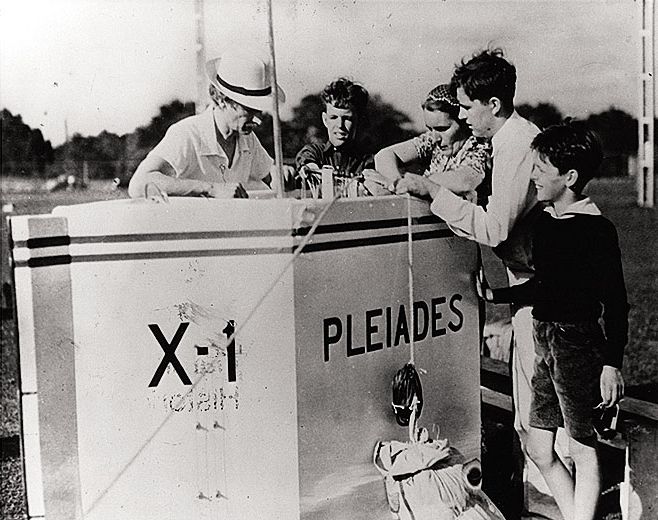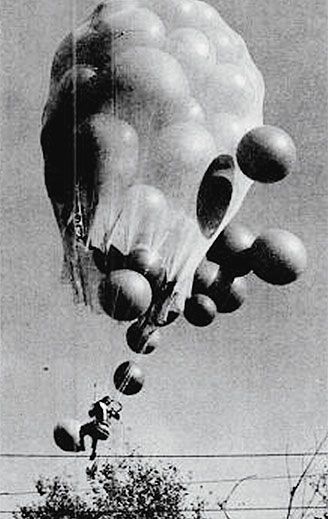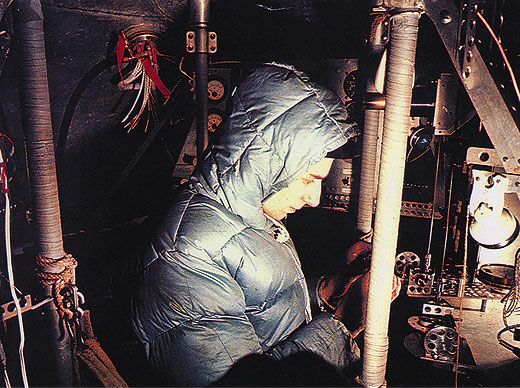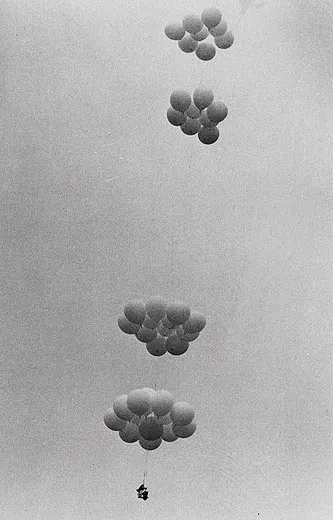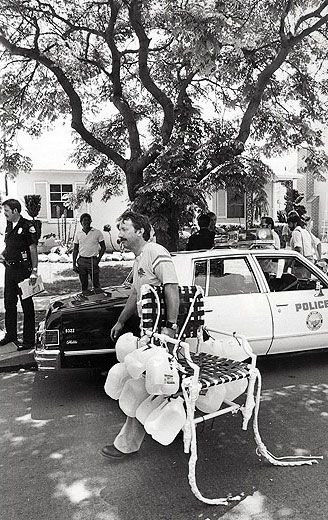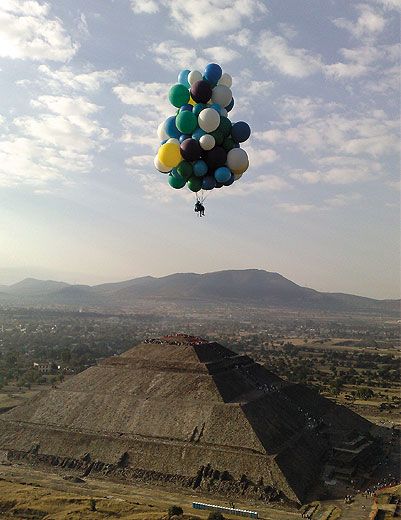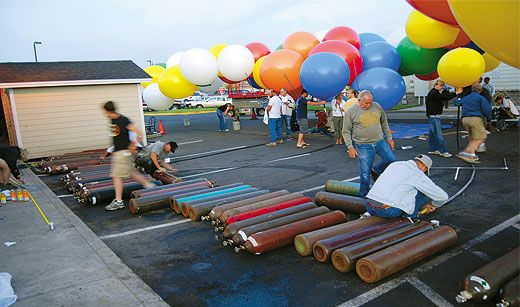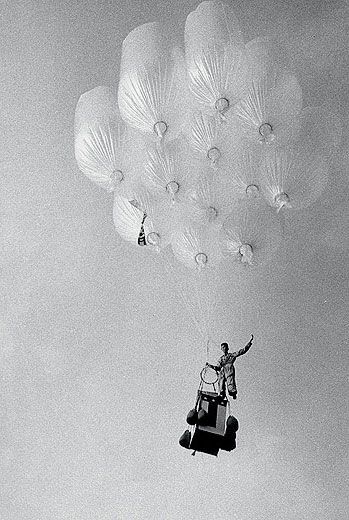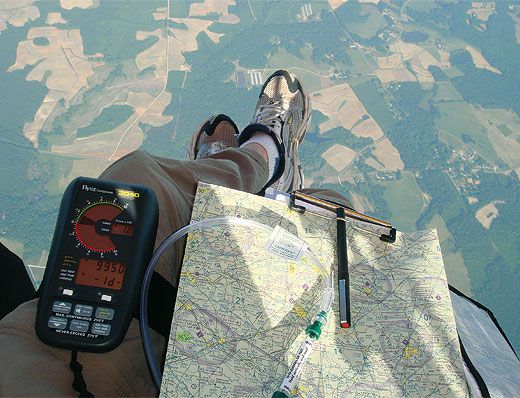The Drifters
Of wind, helium, and hope — plus the occasional disaster.
/https://tf-cmsv2-smithsonianmag-media.s3.amazonaws.com/filer/The_Drifters_FLASH_AUG2010.jpg)
Last May 28, Jonathan Trappe became the first person to fly across a major body of water—the English Channel—while strapped to a cluster of balloons. Flight preparations had begun at midnight, assisted by an assortment of English balloonists, glider and airplane pilots, curious locals, and me.
I am a clinical psychologist, but my interest in people passionately drawn to unusual pursuits led me to cluster ballooning. Not many Americans have heard of it, except as a child’s fantasy, or an image in movies like last year’s Pixar feature Up, but the first actual cluster balloon flight dates back to the 1930s. Eventually, I became so drawn in I took a short break from my practice to volunteer as part of Trappe’s ground crew for the Channel crossing.
The flight was covered by media around the world. The last cluster balloonist to generate that kind of attention was Larry Walters, a truck driver who in 1982 strapped 42 weather balloons to a lawn chair and hurtled himself into the sky over southern California. On national newscasts that evening, Walters’ story introduced an image of the cluster balloonist—part legend-in-the-making, part laughingstock—that remains largely intact. It’s time to reconsider.
What follow are the stories of 10 cluster balloonists from the last seven decades. What were they seeking? Everything from novelty and adventure to scientific knowledge to celebrity and fame. But overall, they fall into two groups: seasoned balloonists and scientists on the one hand, and amateur dreamers and schemers on the other. The first group personifies Daedalus’ caution and skill; the second, Icarus’ sky-struck recklessness.
The Pioneer
Of the sober-minded group, the most famous is Jean Piccard, a Swiss-born aeronautical engineer and balloonist who got interested in using balloon clusters for high-altitude research. (And yes, if you’re wondering—Piccard was the inspiration for Star Trek’s Captain Jean-Luc Picard.) At midnight on July 18, 1937, Piccard, 53, took off from Soldiers Field in Rochester, Minnesota, on the world’s first documented cluster flight. His system was based on over 90 weather balloons. His ground crew included his wife, Jeannette, the first U.S. female balloon pilot licensed by the National Aeronautic Association, the couple’s three sons, and 150 volunteers; 5,000 spectators strained to watch the proceedings.
Emergency fire trucks stood ready, since Piccard planned, over strenuous objections from colleagues, to use TNT charges to release tie-down ropes and, on landing, to cut loose the upper cluster of balloons, filled with hydrogen—highly flammable in the presence of oxygen. He intended to level off between 2,000 and 3,000 feet and guessed that he would remain in the air for about seven hours, drifting 100 to 200 miles.
Two of his predictions proved accurate; the third one missed.
Piccard rose to 11,000 feet—over a mile and a half higher than intended. To descend, he pulled a few balloons down to the gondola and pierced them with a knife—the preferred means for serious cluster balloonists. Guns make good copy, but in the cold of high altitudes, balloons lose elasticity and are harder to deflate by gunshot. (Jeannette Piccard said that, when shot, sounding balloons “just get a small hole and sit there and smile at you.”) After six hours, Piccard landed in a farmer’s wood lot outside Lansing, Iowa.
The Dancer
On September 9, 1954, residents of Albany, New York, looked up to see 60 balloons floating into the sky with a figure beneath. It was Garrett Cashman, a part-time hypnotist and dance teacher, and according to Lawrence Gooley, an authority on the Adirondack region, Cashman was seated on a piece of plywood that dangled from two clusters of balloons; between the clusters, a parachute was slung. Cashman had brought along an anchor, sand for ballast, and a meatloaf sandwich. He rose to over 6,000 feet, floated for about 20 miles, and, immediately upon landing, was arrested for flying without a license and operating an unlicensed aircraft. He was jailed and later fined $50 by the Civil Aeronautics Administration.
He later got both licenses and launched a career flying balloon clusters at airshows and auto races and as an advertising gimmick. After one rough landing in which he sprained his ankle, Cashman told reporters he “might quit the business,” adding, “I like to dance too well.”
The Heir
Twenty years after witnessing his father’s cluster balloon flight as an 11-year-old boy, Don Piccard launched his own cluster system. Piccard, co-founder of the first balloon club in the United States, also created the first super-pressure balloons—in which the volume is kept constant as the pressure changes—and manufactured some of the safest and most distinctive hot-air balloons. For his first cluster flight, Piccard used balloons made of polyethylene film instead of rubber, explaining: “Gas balloons, old army balloons, were very big, very heavy, a lot of work, and took a lot of gas to fly.” By comparison, Piccard’s 40-foot-long methane-filled plastic cylinders were “fairly inexpensive, easy to handle, less work, and very safe.”
In September 1957, Piccard attached himself to 12 balloons and launched from Valley Forge, Pennsylvania. After about two hours, one of the balloons failed. Piccard threw some sand out to compensate, then decided to make a precautionary landing in a farmer’s cornfield. Now 84, Piccard continues to improve balloon systems, using tetrahedron shapes made of Mylar and nylon film, and is organizing a cluster balloon flight to the mesosphere, which begins at about 30 miles above sea level.
The Stargazer
In April 1959, an astronomer and expert balloonist modified Jean Piccard’s design to become the first Frenchman to reach the stratosphere, which starts between eight and 15 miles up. Now 85, Audouin Dollfus is among the foremost French authorities on the solar system, the author of more than 300 scholarly papers, and the discoverer of Janus, one of Saturn’s moons. He is also the son of Charles Dollfus, a famed French balloonist. Interested in observing planetary phenomena without the interference of atmospheric distortion, he organized a stratospheric flight in a sealed capsule with a compact telescope mounted on top. The capsule was suspended from a chain of 105 rubber balloons, each the size of a small truck, that rose nearly 1,500 feet in the air.
Dollfus launched at sunset from an airfield outside Paris. Two hours later, he wrote in his logbook, “I see a perfectly horizontal line—the tropopause, dividing the sky into two parts. The lower part, due to dust-borne particles, resembles an almost-phosphorescent sea whose brilliance surprises me,” while above, “the air is perfectly pure, the stratosphere. The sky is dark, despite the full moon, and the constellations shine without scintillation.” His cluster had reached 46,000 feet—8.7 miles. When he finished his observations, Dollfus triggered explosive charges to release some of the balloons and begin his descent. Upon landing and stepping out into complete darkness, he felt something warm rubbing gently against his skin; it was the nose of a cow.
The Rule-Breaker
Thomas Gatch Jr., the son of a World War II naval hero, failed at nearly everything he attempted before seizing on the idea of being first to cross the Atlantic Ocean by balloon. He constructed a sealed gondola in his garage and attached it to 10 super-pressure gas balloons. Taking off from Harrisburg, Pennsylvania, in February 1974, he intended to ride the jet stream at 38,000 feet. His technical preparations, although extensive, were woefully inadequate for such an ambitious enterprise. According to William Armstrong, who handled his public relations, Gatch had only minimal training in hot-air balloons and none in gas balloons. He had never assembled all the components of his aircraft before the flight, and failed to either pressure-test the balloons at high altitude or float-test the gondola in water. He neglected to rehearse emergency procedures for a water landing, and he launched at dusk; had a problem surfaced early in the flight, rescuers would have had to search in darkness. He repeatedly ignored warnings from seasoned balloon pilots, he failed to get Federal Aviation Administration approval for his craft’s airworthiness, and he notified authorities of the flight only after takeoff.
About an hour into the flight, the center balloon burst. Alluding to the company that manufactured them, Gatch griped to his ground crew, “Tell Raven I want my money back.” Then he lost radio contact. Two days later, crewmen on a freighter in the mid-Atlantic were mesmerized by a ghostly silver sphere floating under a canopy of balloons 1,000 feet in the air—far below Gatch’s intended altitude and hundreds of miles off course. While they couldn’t see all of the gondola’s interior, what they did see showed no signs of life. Search parties were dispatched; they combed hundreds of miles of ocean for weeks. Neither Gatch nor his aircraft was ever found.
The Amateur
Larry Walters had no training or experience as a balloon pilot, but according to Mark Barry, who manages the most authoritative Walters Web site (markbarry.com), the truck driver started preparing for his flight more than 20 years earlier, testing balloons’ lifting properties. And not long before the flight, he took a skydiving lesson. However, Walters had no license for the system he assembled, which consisted of 42 balloons roped to a Sears lawn chair. On July 2, 1982, in the back yard of a small home in San Pedro, California, Walters, then 33, readied for takeoff. He carried jugs of water for ballast and a BB gun to shoot the balloons as a means of descent.
Walters had tethered the chair with two cords to a 1962 Bonneville; he planned to hover close to the ground, safely roped to the car, until ready for free flight, but he had significantly overestimated the amount of helium he would need. When one cord anchoring the chair was cut, the other one snapped from the strain, and Walters rocketed up to 16,000 feet. Soon commercial pilots were calling the tower at the Long Beach airport to report a guy floating three miles up in the airport’s approach path, sitting in a lawn chair and holding a gun.
Walters soon dropped the gun (which he had neglected to tie in) and drifted, shivering in the high-altitude cold, until he slowly began to descend. Coming in to land, he crashed into power lines, briefly blacking out power to part of Long Beach. FAA officials arrived at the scene to find him helplessly suspended in the wires. One of them later said, “We know he broke some part of the Federal Aviation Act and, as soon as we decide which it is, some type of charge will be filed.” For knowingly launching an unauthorized flight in a heavily populated area with congested air traffic, Walters was hit with $4,000 in fines, later reduced to $1,500. He never flew again.
If Walters had flown in a conventional gondola with 42 balloons, the reaction would have been mild amusement; the chair was something else. Few things say “up” less than a lawn chair. Walters transformed an object designed for daydreaming into a vehicle for actualizing his dream. The sheer originality of that act and the goofy charm of his low-tech aircraft made Walters a legend.
The Publicity Hound
Yoshikazu Suzuki thought he could cross the Pacific Ocean under 26 balloons. The Japanese Civil Aviation Bureau questioned Suzuki’s plan. His emergency gear was inadequate and his balloons, filled with only 31,800 cubic feet of helium, were smaller than those used for standard gas balloon races and hardly enough for crossing the Pacific. According to Sabu Ichiyoshi, former chairman of the Balloon Federation of Japan, the only communication device Suzuki carried was a mobile phone, good only on land and within Japan.
He launched in November 1992 and was never heard from again.
“I don’t think he ever received any training to be a balloon pilot,” says Ichiyoshi. “It seems he was a person who likes to see media people.”
The Maestro
John Ninomiya has made more cluster balloon flights than anyone living or dead—to date, over 60. An actuary with a Ph.D. in epidemiology, he was a licensed hot-air balloonist with hundreds of hours of flight experience when he made his first cluster flight, taking off from north of Los Angeles in 1997 with seven Mylar cells supplied by Don Piccard, who drove them from Minnesota to advise and assist.
Ninomiya says that he was drawn to cluster ballooning’s simplicity and purity. “It’s taking ballooning down to its simplest form,” he says. He also wanted to construct his own aircraft, one that could be flown safely and under reasonable control.
He typically uses between 50 and 150 balloons, along with a harness like those favored by paragliders, allowing him to “walk around up there” and to land on his feet. For a balloon and wine festival, Ninomiya has flown under purple and green balloons rigged into the shape of a grape cluster, an arrangement he dubs The Concord.
To burst balloons, Ninomiya carries knives on a lanyard around his neck, “because you don’t want to drop your knife.” Although he has flown as high as 21,400 feet, recreational flights are usually under 5,000 feet.
The Priest
Father Adelir Antonio de Carli, a Catholic priest in Brazil, decided to take off under 1,000 balloons in order to raise funds for a religious charity. De Carli registered at a flight school but refused to attend theory courses, including those on weather, and dismissed his instructors’ warnings about prevailing winds. One teacher characterized him as “undisciplined…not humble at all…the know-it-all guy.” Video clips of his April 2008 takeoff from the port city of Parangue reveal crowds standing under a gray sky in a steady rain. When asked about the ominous weather, de Carli responded, “There will only be good weather during my flight.”
Intending to fly 450 miles inland, he was instead immediately blown out over the Atlantic Ocean. Eight hours later, he was losing altitude and asking how to use his GPS unit—one of many preflight safety procedures he had ignored. He soon lost radio contact. Search parties found his balloons and, two months later, his body. “The Brazilian priest was a complete idiot,” says Don Piccard. “To take off with an offshore breeze and go at altitude with no control and no way to deflate…”
The History-Maker
Before his first cluster balloon flight, Jonathan Trappe spent one year preparing. A technical projects manager from Raleigh, North Carolina, Trappe trained with hot-air as well as single-cell gas balloons. He performed multiple unmanned tests to ascertain the altitudes at which balloons with various amounts of gas would burst, and whether one burst would lead to a chain of others. He wanted to know how many balloons to sacrifice in order to reverse a climb without precipitating a dangerous descent. He researched all Federal Aviation Administration and local air regulations. On June 7, 2008, he took off from Franklin County, North Carolina, and flew for four hours, reaching 15,000 feet and traveling about 50 miles.
Trappe’s original cluster balloon aircraft consisted of a standard Steelcase Uno office chair (the one he used for work every day) and 50 or so chloroprene balloons, plus assorted other gear. Chloroprene is a mixture of latex and neoprene—the material used to make wetsuits—and the mix, says Trappe, “makes a nice ‘boingy’ balloon.”
Trappe’s multiple-balloon system, now featuring a modified climbing harness in lieu of the office chair, is the only one to be granted an Airworthiness Certificate by the FAA, allowing him to fly legally during darkness as well as daylight. Last April 10, he launched at dusk over Raleigh for the first official overnight cluster balloon flight. Landing at dawn 14 hours later, he completed the longest-lasting cluster balloon flight on record.
Just after dawn on May 28, Trappe set out to cross the 22-mile-wide English Channel. Earlier attempts to cross large bodies of water with cluster balloons had cost three men their lives.
With 54 balloons, he took off at dawn from the Kent Gliding Club—the highest elevation in that part of the United Kingdom. Floating over Dover Castle (near where Louis Blériot landed in 1909 on the first airplane flight across the Channel), he passed over the white cliffs of Dover before heading out over water. He flew as high as 7,500 feet but descended at one point to just over 300, where he was able to hear the waves. A picture-perfect flight ended in a hectic landing: To avoid restricted airspace and a looming tower, Trappe had to knife some balloons to descend quickly. He set down in a farmer’s field in northern France, less than two miles from the Belgian border, and was immediately surrounded by French policemen, who threatened to detain him and his crew until they were convinced that he had not violated French airspace.
THE MOST COMMON REACTION when people watch a cluster balloon launch is a giddy, incredulous grin. Cluster ballooning evokes freedom, adventure, escape, breaking away from conventional expectations. The low-tech nature of the aircraft—akin to an aerial soapbox racer—adds to its innocent charm.
The sport does have a controversial image, largely due to the press’ focusing on inexperienced practitioners; that’s roughly equivalent to condemning driving because an unlicensed teenager crashes his dad’s car. Those who have done it right have shown it can be a very safe form of flight.
It is, however, expensive and organizationally complex, costing between $2,500 and $4,000 to launch one flight, without counting costs for reusable items, such as a parachute, transponder, and oxygen tanks. Then there is crew. Ninomiya, for example, says, “I need 15 people for the period of two hours” to inflate and assemble all the balloons. For these reasons, cluster balloonists often look for sponsors, such as balloon festivals and airshows. At venues like these, costs can be subsidized and volunteers mobilized for preflight operations.
The payoff for the balloonist? Jonathan Trappe says that the allure of cluster ballooning is in large part the silence. “We don’t even get the sound of the wind,” he says. “We move perfectly with the wind.” And he points out that cluster ballooning closely resembles how people experience flying in dreams: “floating in the open sky, looking down in silent observance of the world below.”
As for the spectator, he gets to leave the venue with a vivid, indelible memory: the image of someone floating silently into the sky, under a colorful bouquet of beautiful, boingy balloons.
A writer and former New York City cab driver, Mark Karpel drove the chase van for Jonathan Trappe’s English Channel flight.
